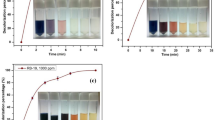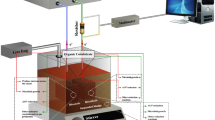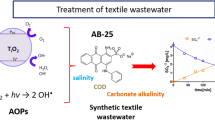Abstract
The accelerating effect of quinones has been studied in the bio-decolorization processes, but there are no literatures about the incorporation bio-treatment technology of the bromoamine acid (BA) wastewater and azo dyes wastewaters under high-salt conditions (NaCl, 15%, w/w). Here we described the BA wastewater as a redox mediator in the bio-decolorization of azo dye wastewaters. Decolorization of azo dyes was carried out experimentally using the salt-tolerant bacteria under the BA wastewater and high-salt conditions. The BA wastewater used as a redox mediator was able to increase the decolorization rate of wastewater containing azo dyes. The effects of various operating conditions such as dissolved oxygen, temperature, and pH on microbial decolorization were investigated experimentally. At the same time, BA was tested to assess the effects on the change of the Oxidation–Reduction Potential (ORP) values during the decolorization processes. The experiments explored a great improvement of the redox mediator application and the new bio-treatment concept.





Similar content being viewed by others
References
Bromley-challenor KCA, Knapp JS, Zhang Z, Gray NCC, Hetheridge MJ, Evans MR (2000) Decolorization of an azo dye by unacclimated activated sludge under anaerobic conditions. Water Res 34:4410–4418
Carliell CM, Barclay SJ, Naidoo N, Buckley CA, Mulholland DA, Senior E (1994) Anaerobic decolorisation of reactive dyes in conventional sewage treatment processes. Water SA 20:341–344
Cervantes FJ (2002) Quinones as electron acceptors and redox mediators for the anaerobic biotransformation of priority pollutants. Ph.D. Wageningen University, Wageningen, The Netherlands, p 166
Dos Santos AB, Bisschops IAE, Cervantes FJ, Van Lier JB (2004) Effect of different redox mediators during thermophilic azo dye reduction by anaerobic granular sludge and comparative study between mesophilic (30°C) and thermophilic (55°C) treatments for decolourisation of textile wastewaters. Chemosphere 55:1149–1157
EPA (1997) Profile of the textile industry. Environmental Protection Agency, Washington, USA
Guo JB, Zhou JT, Wang D, Wang J, Yu H (2005) Decolorization of dye wastewater with high salt concentration by the acclimatized salt-tolerant cultures. J Envirorn Sci 17(6):984–988
Guo JB, Zhou JT, Wang D, Tian CP, Wang P, Salah Uddin M, Yu H (2007) Biocalalyst effects of immobilized anthraquinone on the anaerobic reduction of azo dyes by the salt-tolerant bacteria. Water Res 41(2):426–432
Karigi F, Dinçer, Ali R (1998) Saline wastewater treatment by halophile-supplemented activated sludge culture in an aerated rotating biodisc contactor [J]. Enzyme Microb Technol 122:427–433
Kargi F, Uygur A (1996) Biological treatment of saline wastewater in an aerated percolator unit utilizing halophilic bacteria. Environ Technol 17:325–330
Keck A, Klein J, Kudlich M, Stolz A, Knackmuss HJ, Mattes R (1997) Reduction of azo dyes by redox mediators originating in the naphthalenesulfonic acid degradation pathway of Sphingomonas sp. strain BN6. Appl Environ Microbiol 63:3684–3690
Lee YH, Pavlostathis SG (2004) Reuse of textile reactive azo dyebaths following biological decolorization. Water Environ Res 76(1):56–66
Lee YH, Matthews RD, Pavlostathis SG (2005) Anaerobic biodecolorization of textile reactive anthraquinone and phthalocyanine dyebaths under hypersaline conditions. Water Sci Technol 52(1–2):377–383
Manu B, Chauhari S (2003) Decolorization of indigo and azo dyes in semicontinuous reactors with long hydraulic retention time. Process Biochem 38(8):1213–1221
Panswad T, Anan C (1999) Impact of high chloride wastewater on an anaerobic/anoxic/aerobic process with and without inoculation of chloride acclimated seeds [J]. Water Res 33:1165–1172
Peyton BM, Wilson T, Yonge DR (2002) Kinetics of phenol biodegradation in high salt solutions. Water Res 36(19):4811–4820
Qu YY, Zhou JT, Wang J, Fu X, Xing LL (2005) Microbial community dynamics in bioaugmented sequencing batch reactors for bromoamine acid removal. FEMS Microbiol Lett 246:143–149
Russ R, Rau J, Stolz A (2000) The function of cytoplasmic flavin reductases in the reduction of azo dyes by bacteria. Appl Environ Microbiol 66:1429–1434
Van der Zee FP, Bisschops IAE, Lettinga G, Field JA (2003) Activated carbon as an electron acceptor and redox mediator during the anaerobic biotransformation of azo dyes. Environ Sci Technol 37:402–408
Woolard CR, Irvine RL (1995) Treatment of hypersaline wastewater in the sequencing batch reactor. Water Res 29:1159–1168
Zollinger H (1987) Color chemistry—syntheses, properties and applications of organic dyes and pigments. VCH Publishers, New York, pp 92–102
Acknowledgment
This study was supported by the Cross-Century Talent Fund of National Education Committee of China and the National Natural Science Foundation (People’s Republic of China).
Author information
Authors and Affiliations
Corresponding author
Rights and permissions
About this article
Cite this article
Guo, J., Zhou, J., Wang, D. et al. The new incorporation bio-treatment technology of bromoamine acid and azo dyes wastewaters under high-salt conditions. Biodegradation 19, 93–98 (2008). https://doi.org/10.1007/s10532-007-9118-6
Received:
Accepted:
Published:
Issue Date:
DOI: https://doi.org/10.1007/s10532-007-9118-6




